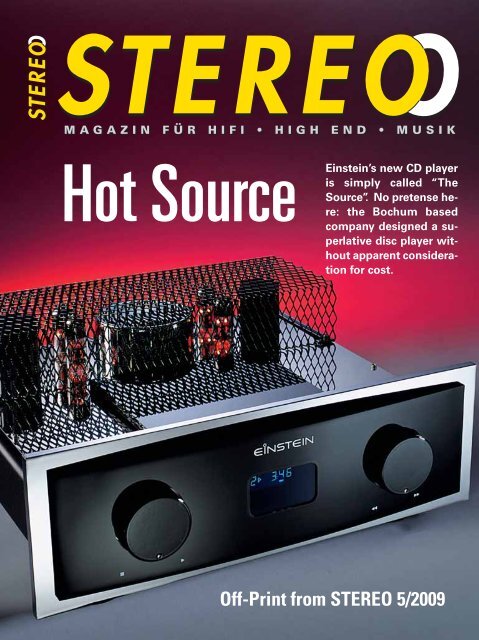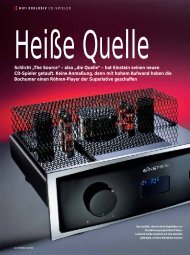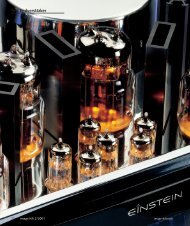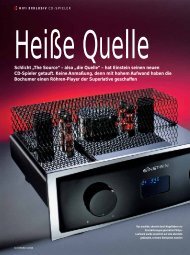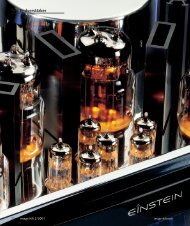Off-Print from STEREO 5/2009 - Einstein - Audio Components
Off-Print from STEREO 5/2009 - Einstein - Audio Components
Off-Print from STEREO 5/2009 - Einstein - Audio Components
Create successful ePaper yourself
Turn your PDF publications into a flip-book with our unique Google optimized e-Paper software.
MAGAZIN FÜR HIFI • HIGH END • MUSIK<br />
Hot Source<br />
<strong>Einstein</strong>’s new CD player<br />
is simply called “The<br />
Source”. No pretense here:<br />
the Bochum based<br />
company designed a superlative<br />
disc player without<br />
apparent consideration<br />
for cost.<br />
<strong>Off</strong>-<strong>Print</strong> <strong>from</strong> <strong>STEREO</strong> 5/<strong>2009</strong>
instein_0509_sonderdruck-Englisch.qxp:<strong>STEREO</strong> 28.08.<strong>2009</strong> 13:54 Uhr Seite 50<br />
supplied metal puck centers it and voila,<br />
you are ready to go.<br />
The CDM2 pro houses both the spindle<br />
and laser unit on top of a sprung, massive<br />
aluminum base plate. This construction<br />
usually offers a well balanced<br />
approach to a stiff chassis through effective<br />
decoupling of the transport. Of<br />
course, this wasn’t enough for the <strong>Einstein</strong><br />
crew: instead, they placed the CDM2<br />
pro on top of yet another, weight optimized<br />
and suspended steel plate, yielding in<br />
effect a cleverly constructed twin chassis<br />
player.<br />
a classic OTL design, which are visible<br />
through the unit’s rear mounted tube cage.<br />
Until the signal reaches the output<br />
stage however, it passes through a considerable<br />
path. It all begins with the unit’s<br />
side sweeping black acrylic CD cover, underneath<br />
which you find Philip’s tried and<br />
true CDM2 pro disc drive. Unlike say for<br />
example Esoteric’s VRDS design, which<br />
clearly lies in an even higher league, this<br />
classic disc drive mechanism is leaps and<br />
bounds above the mass manufactured<br />
DVD-ROM based transports available on<br />
the market. Two depressions next to the<br />
disc allow for an easier placement and<br />
handling of the disc inside the player; alas,<br />
this task is still somewhat finicky. Once<br />
a disc is placed on top of the spindle, a<br />
By Matthias Böde<br />
t seems that <strong>Einstein</strong> jumped the gun<br />
somewhat with their 2003 release of<br />
their then new CD player, appropriately<br />
labeled “The Last Record Player”. Good<br />
then that the word caution wasn’t part of<br />
<strong>Einstein</strong>’s latest creation. Aptly named<br />
“The Source”, it is quite clear that <strong>Einstein</strong><br />
intends to position their latest disc player<br />
at the very top of source components.<br />
Prerequisite for such a task are this 38<br />
pound unit’s two large, well formed selector<br />
switches, perfectly set against <strong>Einstein</strong>’s<br />
classic black acrylic faceplate. It<br />
yields a true double-mono construction,<br />
which in <strong>Einstein</strong>’s classic fashion boasts<br />
a tube analog output stage. Each channel<br />
utilizes two double triode 6N30 tubes in<br />
I<br />
The tube<br />
outputstage clearly<br />
shows the high standard of<br />
this real balanced double mono concept.<br />
converter section via an opto-coupler.<br />
This galvanic<br />
separation ensures that the<br />
drivetrain, electronics and<br />
controller are free of<br />
electric mains hash. In<br />
typical <strong>Einstein</strong> fashion,<br />
the unit’s<br />
power supply<br />
is controlled<br />
and regulated<br />
via 14 voltage sources,<br />
separated each into the<br />
analog and digital section. Each<br />
voltage source is supplied via 3 separate<br />
transformers, one for the drive mechanism<br />
and logic, and two for the digital to<br />
analog converter and output stage. Interestingly,<br />
there is only a single on / off<br />
mains switch, located at the back of the<br />
unit. According to <strong>Einstein</strong>, a third switch<br />
would have looked misplaced on the<br />
unit’s otherwise simplistic acrylic faceplate.<br />
Thus if someone wants to switch<br />
3 Transformers, 14 voltage sources<br />
The data collected off the disc reaches the<br />
sed individually inside an aluminum<br />
chassis situated directly before the tube<br />
section. Sure, you may find some manufactures<br />
who laugh at the chosen path; a<br />
high part count and an overall perceived<br />
antiquated design usually means lots of<br />
headaches. In the end, it’s all well worth<br />
it, as the sonic revelations clearly showcase.<br />
We were forewarned as we played the very<br />
first disc and The Source left Lindemann’s<br />
SACD player outclassed, outgunned. The<br />
<strong>Einstein</strong> played so free, full of explosive<br />
energy, that the Lindemann 820 by comparison<br />
appeared small, average and otherwise<br />
rather simplistic. The Source<br />
presents are large, well organized and defined<br />
sound stage: each instrument takes<br />
it’s own place; image sizes are well proportioned<br />
and played back with realistic<br />
plasticity. That <strong>Einstein</strong> placed correct<br />
group delay equalization and phaseshift<br />
at the top of the design goal becomes<br />
quickly evident.<br />
Outstanding sonics demand superior<br />
design<br />
No one should be confused by<br />
CATCHWORD the unit’s 24 bit, 192khz Burr-<br />
The group delay Brown digital to analog con-<br />
(time):<br />
verters. A unique upsampling<br />
This parameter des-<br />
or word length conversion tacribes<br />
how fast all<br />
frequencies pass the kes place in this unit, ie. The<br />
device. High syn- data remains true to the 16 bit<br />
chronicity is impor- 44.1khz CD standard. In the<br />
tant for a perfect<br />
stereo performance. end, you find the same relationship<br />
with pretty much<br />
everything else: to merely get<br />
good sound, simplicity simply works.<br />
Getting great sound however, involves a<br />
much higher set of skills.<br />
Another example of this higher order design<br />
calling is the unit’s atypical fully discrete<br />
built digital filter section. Typically,<br />
custom made op-amps would handle<br />
this task; <strong>Einstein</strong> however felt that this<br />
solution results in a loss of about 4 decibel<br />
in signal to noise ratio, hence their decision<br />
to utilize this fully symmetrical filter<br />
design. Two of these filters are hou-<br />
The Source on and off, they<br />
have to reach well behind the<br />
unit. That’s “high-end” for<br />
you!<br />
TEST EQUIPMENT<br />
(SA)CD-PLAYER: Accuphase DP-700, Lindemann<br />
820S, Nagra CDC<br />
PRE-/POWERAMP.: Linn Klimax Kontrol/Soulution 710<br />
LOUDSPEAKER: Ayon GyrFalcon, Dynaudio Contour<br />
S5.4, Vienna Acoustics „The Kiss“<br />
CABLE: HMS Gran Finale Jubilee, Lindemann<br />
„Kind of Blue“, Nordost Valhalla<br />
RACK: Finite Elemente Pagode Reference<br />
The rock solid, suspended via conical<br />
helical springs, Philips drive sits on top of yet<br />
another suspended steel plate to<br />
minimize any vibrations
CD player with analog timbre<br />
The Source plays back each digital disc<br />
with a familiar analog like tune. Highs<br />
are silky smooth, without a hint of any<br />
hardness or artificial tone. Voices are<br />
equally natural and lifelike without any<br />
signs of harshness. Bass is another<br />
strong suit of the <strong>Einstein</strong> player: dependent<br />
on the source material it always<br />
appears tonally correct, with superb timing.<br />
Even our now two year old reference,<br />
Nagra’s CDC disc player appeared<br />
to have been put in<br />
it’s place. Sure, it is pretty<br />
much the equal of the<br />
<strong>Einstein</strong> when it comes<br />
to recreating great<br />
sounding three dimensional<br />
aural landscapes;<br />
the <strong>Einstein</strong> however<br />
outclasses it<br />
The clock generator packaged<br />
in silver sits close to the converter section.<br />
Complex power supply design<br />
when it comes to picture<br />
perfect tonal colors and<br />
a natural, authentic<br />
musical aura. Ultimately,<br />
the Nagra<br />
sounds more like a<br />
CD player - a very fine<br />
one at that; alas, The Source sounds<br />
more like a reference record player, managing<br />
to extract almost hypnotic<br />
soundscapes of amazing musical qualities.<br />
Only Accuphase’s DP700 comes close<br />
to that level of quality music playback,<br />
albeit when fed with SACDs.<br />
The sensation is thus perfect. Nagra’s otherwise<br />
outstanding sounding disc play-<br />
Along with the pre amplifier<br />
“The Tube” and the<br />
mono amplifiers “The Final<br />
Cut”, “The Source”<br />
completes <strong>Einstein</strong>’s tube<br />
based line. <strong>STEREO</strong> – Test<br />
01/2003<br />
Each channel has its<br />
own discretely built digital filter<br />
built inside this aluminum chassis<br />
er has been dethroned and has to make<br />
way for the new <strong>Einstein</strong> player. Not only<br />
does The Source sit on top of the sonic<br />
ladder, it seems to somehow act as a link<br />
between both analog and digital worlds.<br />
The Source is rightfully named as the<br />
source of sonic bliss - for those looking<br />
to get a new player simply a must!<br />
Stereo’s summit of reference CD players<br />
resulted in a massive shootout<br />
EINSTEIN THE SOURCE<br />
um €9900<br />
Dimantion 43x18,5x43 cm (BxHxT)<br />
Guarante: 5 Jahre<br />
Vertrieb: <strong>Einstein</strong> <strong>Audio</strong> <strong>Components</strong><br />
Tel.: 0234/9731512, www.einstein-audio.de<br />
<strong>Einstein</strong>’s new disc player is full of clever<br />
design elements. The Source plays back<br />
music with uncanny reality and musical insight.<br />
Since the measurements are equally<br />
outstanding, The Source easily lays claim<br />
to the top reference spot of CD players.<br />
Well deserved!<br />
LABOR<br />
The <strong>Einstein</strong> player displays a very linear<br />
frequency response curve, marred only marginally<br />
by a drop of 1 decibel with rare emphasis<br />
enabled discs. It passes the trusted<br />
square edge and impulse tests well<br />
enough; of course, we always look closely<br />
at distortion and signal to noise ratio numbers.<br />
Interestingly, The Source is nearly indistinguishable<br />
<strong>from</strong> reference level solid<br />
state designs in this respect. 0,19% distortion<br />
(400hz / -60db) and merely 0,012%<br />
aliasing distortion (-30db) are simply exemplary.<br />
Equally outstanding are the signal to<br />
noise ratios of 106db at digital zero<br />
and 90db quantization noise.<br />
Note that these numbers correspond<br />
to measurements achieved<br />
<strong>from</strong> the non balanced outputs;<br />
they would be about 6 db higher if<br />
measured through the balanced output<br />
stage. Converter linearity is also<br />
outstanding, achieving a maximum<br />
0,1db of error at -90db. Philip’s quiet<br />
transport has no problems reading CDR<br />
and CDRW discs or discs with scratches<br />
and other surface issues. Output impedance<br />
is 114 Ohms and it draws 73 Watts<br />
of power at idle. There are no provisions<br />
for a standby modus.<br />
LAYOUT<br />
One output each balanced and non balanced,<br />
coaxial digital output, wireless remote<br />
control.<br />
SOUND<br />
100 %<br />
PRICE/PERFORMENCE<br />
VERY SEHR GOOD<br />
GUT


